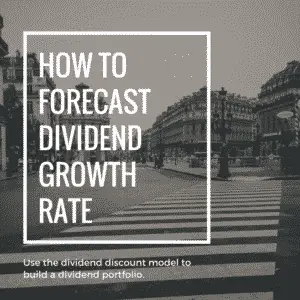If you use a dividend discount model to build a dividend portfolio, you may know that the biggest input is the dividend growth rate. We are going to give you a few points on how to forecast the dividend growth rate to finalize your dividend discount analysis. We have a primer on how to use the dividend discount model to build a dividend portfolio. Here how to forecast dividend growth rate.
How to Forecast Dividend Growth Rate: Build a Dividend Model
If you are a dividend-oriented investor (like myself), you are always trying new ways to find the best dividend growth opportunities. One simple model that I use as a gut check is the short-form dividend discount model.
This is a quick and dirty analysis on how to value a dividend stock by discounting the future value of their dividends. You can download our version of the dividend discount model for free. We hope this helps you build a better dividend portfolio.
When using the dividend discount model, the most sensitive input is the dividend growth rate. In order to have a proper output of the model, you need to know how to forecast dividend growth rate.
I’ve been investing in a dividend income portfolio to achieve financial freedom. I created a free dividend investing calculator to help you understand what it will take to retire off dividends.
What is the Dividend Growth Rate?
The dividend growth rate is the annualized percentage rate of growth that a stock’s dividend undergoes over a period of time. The time included in the analysis can be of any interval desired and is calculated by using the least squares method or by simply taking a simple annualized figure over the time period.
Dividend growth rate is a crucial component of a dividend growth investing strategy. However, it is not the only component to dividend investing. Just like why you shouldn’t buy stocks solely off of annual dividend yield. I like to look at dividend stocks on a valuation basis first.
Ways of Forecasting Dividend Growth Rate
Currently, in this volatile market, it’s much better and safer if you analyze a company’s dividend growth to gauge performance than look for high yield. One of the best ways to forecast is doing a look back on historical dividend growth rates of a company (of course). That really the best way to understand the future outlook. However, we all know that using historical data does not predict future success.
By taking the historical dividend growth rate, you can at least use that as a baseline to adjust the expected dividend growth rate accordingly based on your judgment. Your judgment for adjusting the expected dividend growth rate should include:
- What is the anticipated next fiscal year earnings growth for dividend stock?
- What is the payout ratio of the dividend stock?
- What is the long-term earnings growth of the dividend stock?
- What is the industry outlook look like? Is the industry expected to grow?
If you’d like to get more granular with your expected dividend growth rate analysis, you can use the two-stage dividend growth model to build an exact analysis of the growth rate of dividends based on the above factors.
Expert Opinion on How to Forecast Dividend Growth Rate
In a recent podcast, we listened to on Advisor in Canada about the best ways to predict dividend growth with Craig Jerusalim.
“A company with a high yield does not translate to a good company, nor a safe investment,” says Craig Jerusalim, portfolio manager of Canadian equities at CIBC Global Asset Management. He co-manages the Renaissance Diversified Income Fund, which is a Canadian dividend growth fund focused on generating a high level of income and long-term capital growth by investing primarily in income producing securities including common shares, preferred shares, income trusts, and fixed income securities. “Over the long term, the majority of total shareholder return [can] come from dividends—a figure that some peg as high as 67% to 80%.”
But he warns, “A large negative price movement can completely wipe out years of dividend payments, in the short-term. That’s why it’s imperative to focus on dividend sustainability and dividend growth opportunities, rather than outright yield.”
Jerusalim has stated that Energy is one sector where close analysis really pays off. “There are at least a dozen energy companies on the TSX with yields greater than 10%, all of which have one-year total returns ranging from -30% to -80%. There’s clearly a lack of price support from dividends.”
Because of this, these energy companies are going to have to continue to reduce their dividends because of the low energy prices. During all of this, companies that are in other sectors will most likely have low yields but they’ll have better dividend outlooks. “Despite weak share price performance, these companies [are] seeing significant growth opportunities, and have the capacity and wherewithal to increase dividends without increasing operating risk.”
“There are two indicators to look at when determining whether a company’s dividends have growth potential and are sustainable,” says Jerusalim.
Examples of these indicators are things like if a company has “the flexibility of a low payout ratio.” If companies forecast positive earnings growth, payout ratios typically trend lower.
Whether a company has a return on capital that exceeds its cost of capital, “so that each dollar of earnings can be properly reinvested in the business for additional future growth.”
Conclusion on How to Build a Dividend Forecast
Forecasting dividend growth is a key component to your dividend growth investing strategy. Without the proper dividend forecast, you can make or break a proper dividend investment. Or even your entire portfolio.
Do you know how to forecast dividend growth rate? What effective ways to you use to build a dividend portfolio? We’ve given you a list of 7 Great Dividend Growth Stocks for a Secure Retirement.
Additionally, if you want to diversify trying using global dividend growth funds to increase your international exposure.
Subscribe to our newsletter for more fantastic updates like the above (we do not send spam).







No Comment